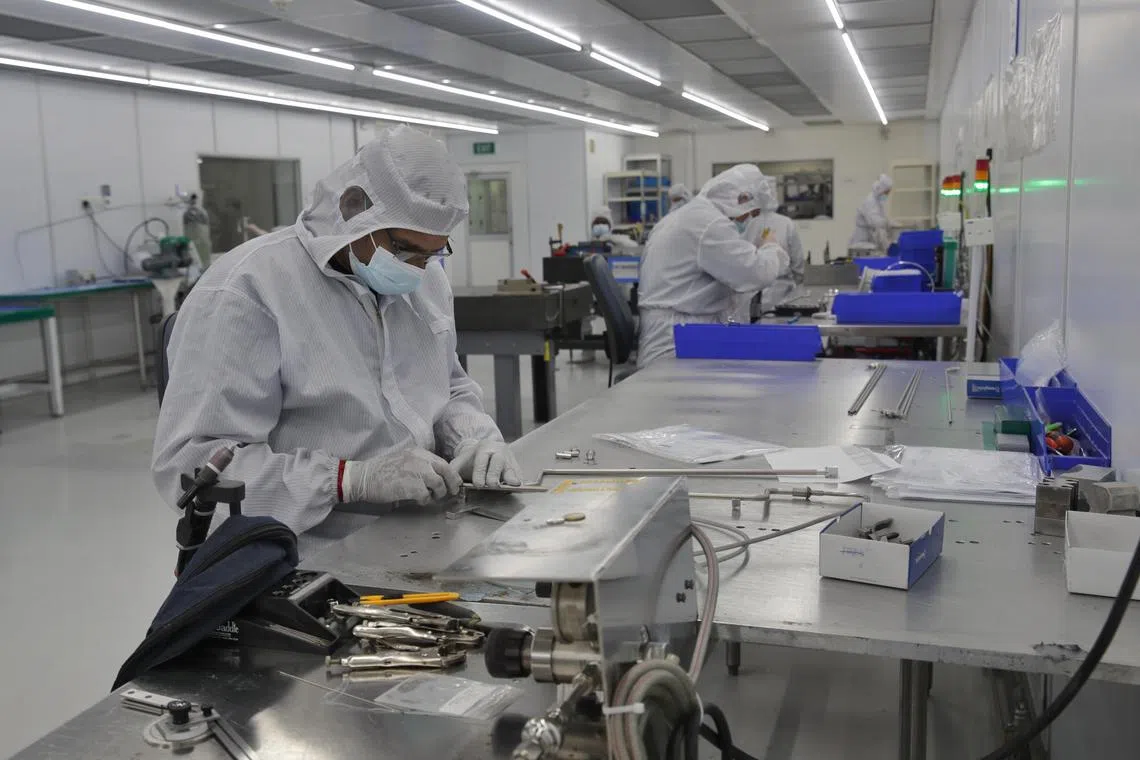Singapore’s factory output snaps year-long slump with 7.4% rise in October
Sign up now: Get ST's newsletters delivered to your inbox

Electronics production rose 14.8 per cent year on year, with the semiconductor segment expanding 17.8 per cent.
PHOTO: ST FILE
Follow topic:
SINGAPORE – Factory output rose here in October after 12 straight months of decline, thanks to growth in the key electronics industry, particularly semiconductors.
Total manufacturing production rose 7.4 per cent over the same month in 2022, after an upwardly revised 1.1 per cent drop in September, according to the Economic Development Board on Nov 24.
Excluding volatile biomedical manufacturing, October output increased by 7.3 per cent.
Production on a seasonally adjusted month-on-month basis expanded 9.8 per cent in October over September. Excluding biomedical manufacturing, it grew 4.4 per cent.
Notably, the turnaround was led by the electronics industry, which accounts for about 45 per cent of local manufacturing production.
Electronics recorded a 14.8 per cent year-on-year jump, with the semiconductor segment expanding 17.8 per cent. This was the second straight month of expansion for both electronics and chip production.
In contrast, other electronics modules and components declined by 2.4 per cent, while computer peripherals and data storage tumbled 10.3 per cent.
The transport engineering industry also helped lift the overall manufacturing sector, with output rising 12 per cent.
Much of this was due to a 20.2 per cent surge in marine and offshore engineering amid higher levels of activity in shipyards, alongside increased output in oil and gas-field equipment.
This was further aided by the aerospace segment’s 15.9 per cent expansion on the back of higher demand for aircraft parts and additional maintenance, repair and overhaul jobs from commercial airlines, which, in turn, benefited from strong air travel demand globally.
The biomedical sector also thrived, with output growing 5.1 per cent.
In particular, the medical technology segment expanded 8.2 per cent amid higher export demand for medical devices, while pharmaceuticals increased 3.3 per cent, buoyed by a shift in the mix of active ingredients being produced.
On the flip side, chemicals posted a 1 per cent decline, largely due to the petrochemicals segment, which shrank 9.9 per cent, partly due to plant shutdowns for maintenance.
Output in the precision engineering sector also fell, slipping 2.2 per cent year on year. This was due largely to a sharp drop in the precision modules and components segment, which fell 20.5 per cent, whereas machinery and systems production rose 3.3 per cent on healthier demand for semiconductor-related equipment.
Meanwhile, general manufacturing output advanced 4.3 per cent, with the food, beverage and tobacco segment up 6.7 per cent, while miscellaneous industries gained 4.8 per cent, helped by more construction-related materials produced. Together, they mitigated the 9.9 per cent fall in printing.

DBS economist Chua Han Teng said: “The data confirms that the worst of the slump is behind us, following corroborating improvements in other forward-looking indicators.”
However, he warned that activity remains uneven across many other clusters and more data points are needed to get a clearer picture of the pace of recovery.
“The global economic backdrop is still uncertain; high interest rates in advanced economies, bumpy conditions in China and lingering geopolitical tensions could yet disrupt supply chains. These could keep Singapore’s manufacturing recovery fragile,” he noted.
Maybank economist Brian Lee said that while a recovery had been anticipated, “the strength of the rebound exceeded our forecast”.
However, he noted that the numbers may be flattered by the low base of comparison, particularly for exports and manufacturing.
Nevertheless, he expects fourth-quarter economic growth to exceed 2 per cent year on year, adding that the latest data confirms that the economy is on track for a stronger recovery heading into the new year, led by outward-facing sectors.
UOB associate economist Jester Koh was more guarded in his assessment.
He felt that external demand in the first half of 2024 could remain constrained by the still-elevated interest rate environment in the US and Europe, while consumer and business sentiment may be hampered by weakness in China’s property sector.
Mr Koh said signs of a broader manufacturing recovery could emerge towards the middle of 2024 on the back of a gradual recovery in external demand.
However, this is contingent on central banks in advanced economies cutting policy rates in tandem with easing inflation, he said, adding that “the consequent improvement in financial conditions would then provide the much-needed support for consumption and investments”.


